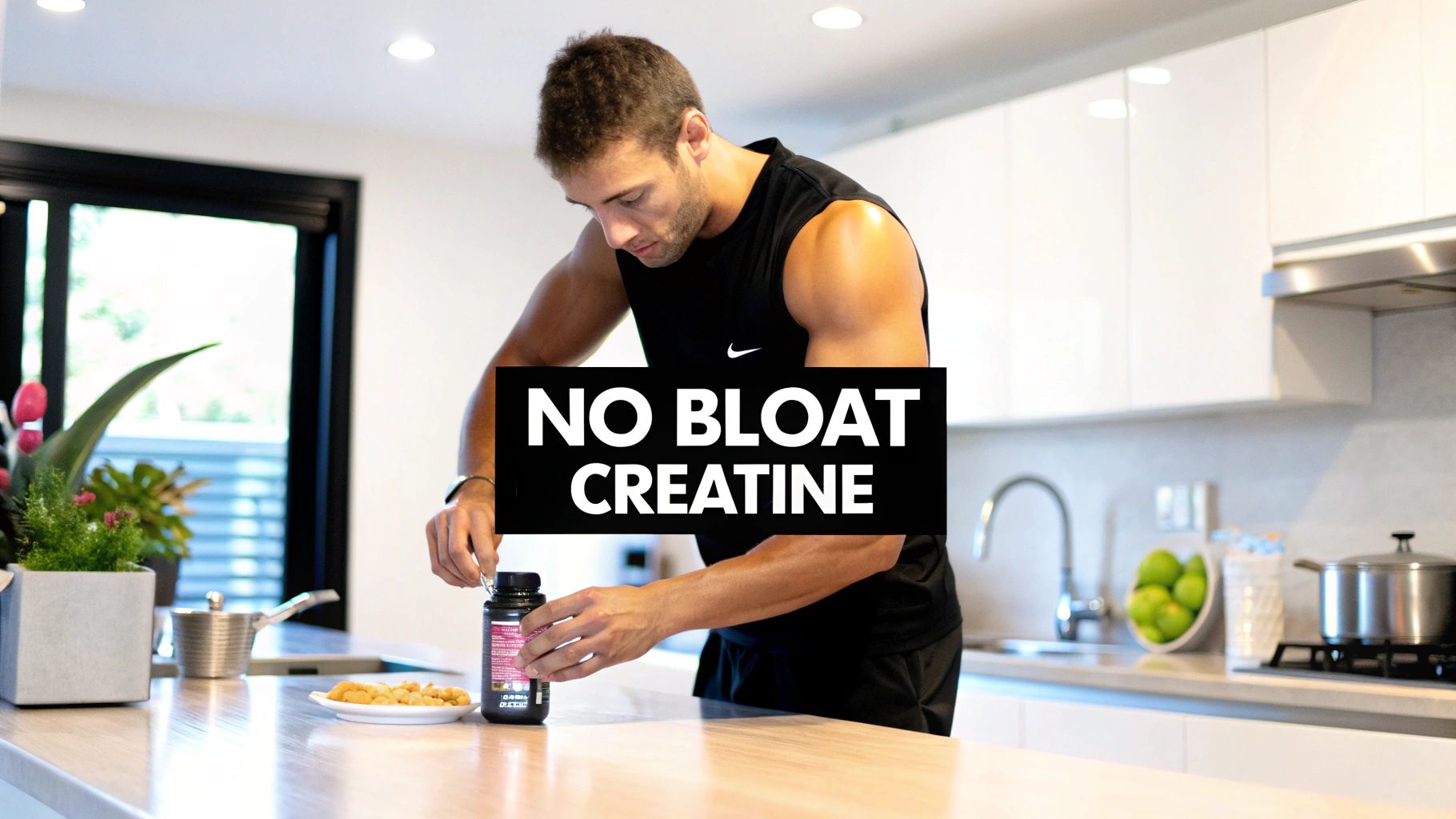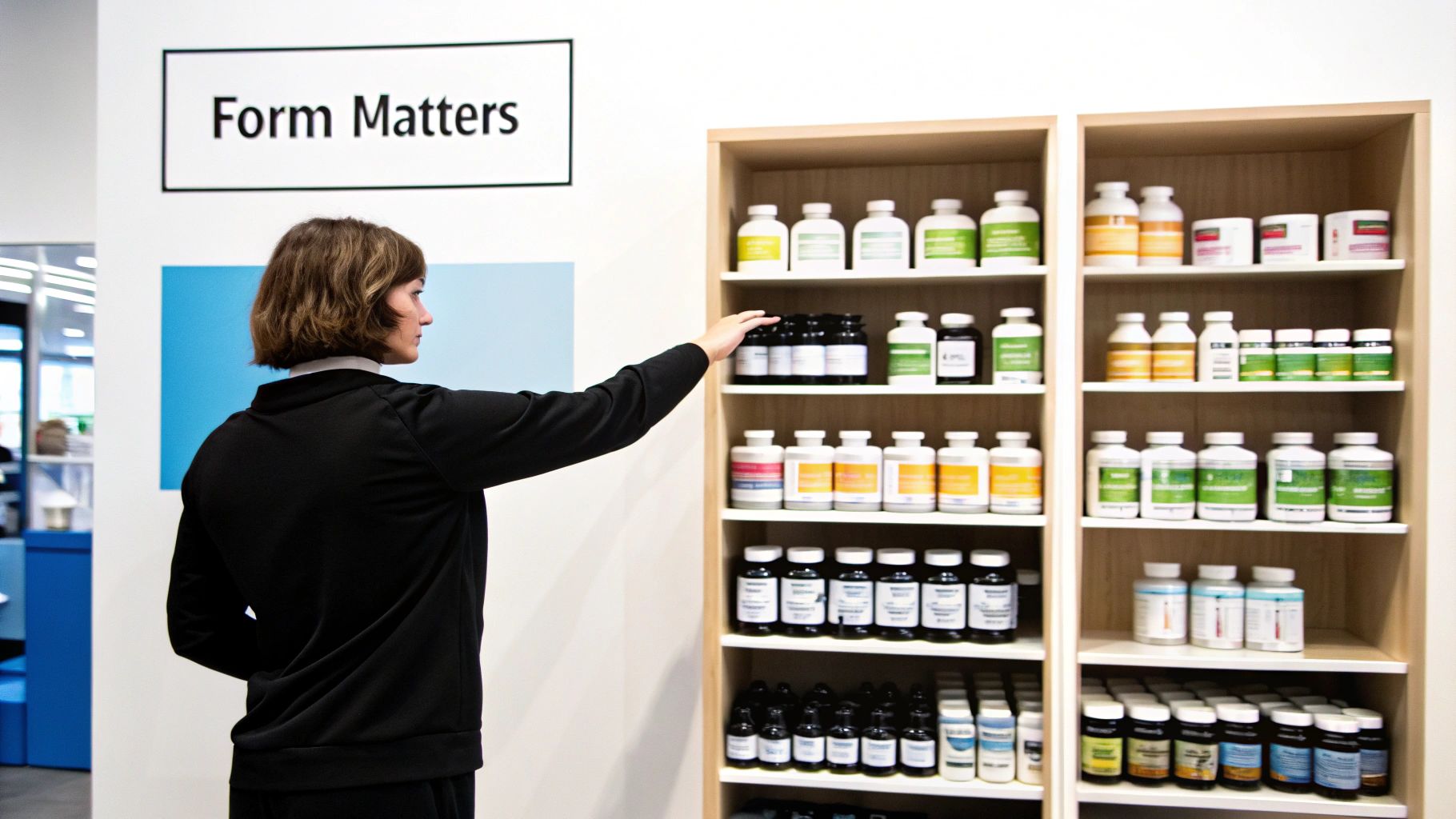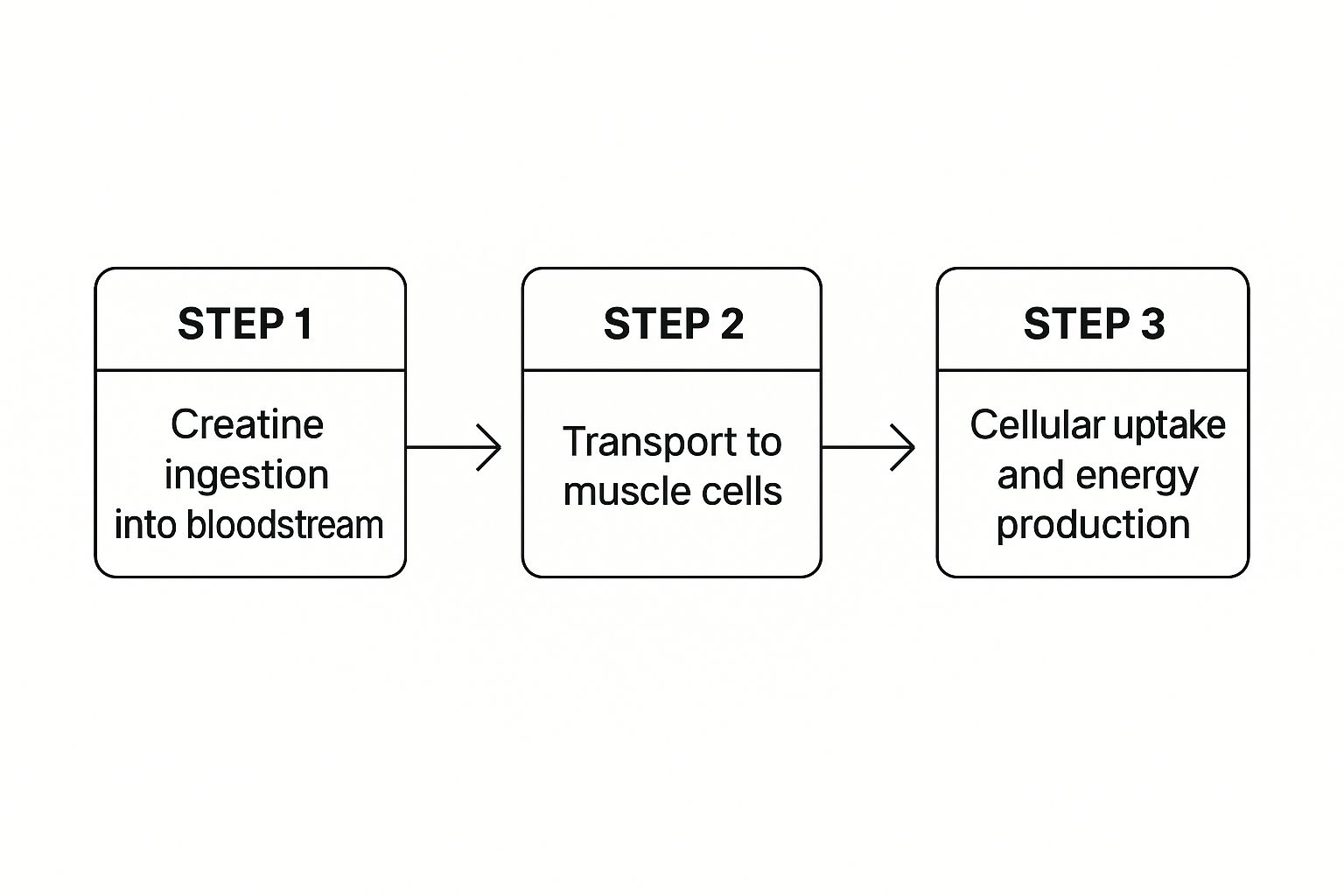
Your Guide to Creatine No Bloating
Share
Yes, finding a creatine with no bloating is possible, but it starts with knowing why you feel bloated in the first place. That initial jump on the scale? It's usually just water being pulled into your muscle cells—which is a good thing—not the uncomfortable puffiness you’re trying to avoid.
Why Creatine Can Make You Feel Bloated

Let's clear the air on a common myth: not all water weight from creatine is bad. The real trick is knowing the difference between the two types of water retention going on in your body.
When you take creatine, it pulls water directly into your muscle cells. This is called intracellular water, and it's exactly what you want. It's the mechanism that makes your muscles look fuller and helps boost performance and recovery.
That uncomfortable, puffy feeling you call "bloating" comes from extracellular water—the water held outside your muscle cells, just under the skin. This is what can leave you feeling soft and less defined.
Intracellular Vs. Extracellular Water Retention
Here’s the good news: the initial weight gain you see from creatine is almost always from that beneficial intracellular water. Studies have shown that while creatine does increase your total body water, it doesn't necessarily spike the extracellular fluid levels that cause that bloated look. Instead, the water is going right where you need it—inside the muscles.
This initial hydration is a positive sign that your muscles are getting properly saturated and primed for growth. If you’re curious about what to expect, you can learn more about how much weight gain from creatine is normal in our detailed guide.
That initial 2-4 pound jump on the scale isn't really "bloat." Think of it as your muscles getting super-hydrated and ready to perform at their best.
So, when people look for a "creatine no bloating" solution, they're really trying to maximize muscle hydration while keeping that unwanted subcutaneous water retention at bay. The key lies in your creatine type, dosing strategy, and overall hydration habits.
Creatine Types and Their Bloating Potential
Not all creatine is created equal when it comes to mixability and digestion. Some forms dissolve better in water, which can lead to less stomach discomfort and a lower chance of feeling bloated.
Here’s a quick rundown of the most common types:
| Creatine Type | Key Feature | Bloating Potential |
|---|---|---|
| Monohydrate | Most researched, proven effective. | Moderate: The standard. Bloating is possible, especially with lower-quality, gritty powders. |
| Micronized Monohydrate | Finer particles for better solubility. | Low: Mixes more easily, which may reduce stomach upset and the feeling of bloat for many. |
| Creatine HCl | Bonded with hydrochloric acid for enhanced solubility. | Very Low: Requires a smaller dose and dissolves extremely well, often a top pick for those sensitive to bloating. |
| Creatine Ethyl Ester | Claimed to have better absorption. | Low to Moderate: Less research, but some users report less water retention compared to standard monohydrate. |
Ultimately, choosing a form with better solubility, like Micronized Monohydrate or Creatine HCl, can often be a game-changer if you're prone to gastrointestinal issues or that puffy feeling.
Choosing the Right Creatine to Avoid Bloat
The kind of creatine you take can make a world of difference in how you feel. Walk down any supplement aisle, and the options are dizzying. But if you know what to look for, you can easily sidestep the dreaded creatine bloat.
For the vast majority of people, creatine monohydrate is the gold standard. It’s the most studied, most effective, and usually the most affordable option out there. If you've had trouble with it before, don't write it off just yet—try a micronized version first.
Why Micronized Monohydrate Is a Smart First Choice
Micronized creatine simply means the powder has been milled into finer particles. Think about trying to stir sand into a glass of water versus stirring in fine flour. The flour mixes in easily, while the sand just sinks. That’s what micronization does; it improves how well the creatine dissolves, making it gentler on your stomach and less likely to cause issues.
It's easy to mistake muscle hydration for bloating. When you first start creatine, it's normal to see the scale jump up by 2-4 pounds. This is just water being pulled into your muscle cells—exactly what you want—not puffiness under your skin. You can learn more about this initial water retention process and its effects.
What About Other Creatine Options?
You’ll also see other forms on the shelf, like Creatine Hydrochloride (HCl). The main selling point for HCl is its incredible solubility. The idea is that you can take a much smaller dose and still get the benefits, which in theory means less chance of stomach upset or water retention.
While it definitely dissolves better, the performance benefits just aren't backed by the mountain of research that monohydrate has. Still, for anyone with a particularly sensitive stomach, HCl can be a lifesaver. It just tends to be more expensive. It really comes down to what your body tolerates and what your wallet allows.
If you're weighing your options, this detailed comparison between Creatine Hydrochloride vs. Monohydrate can help you make the final call.
At the end of the day, starting with a high-quality, micronized creatine monohydrate is the most reliable path for getting all the strength and performance gains without the bloat.
Fine-Tuning Your Dosing Strategy to Avoid Discomfort

When it comes to creatine, a "more is better" mindset is a fast track to discomfort. I've seen it time and time again: someone gets excited to start, follows an old-school "loading phase," and ends up feeling puffy and bloated.
This aggressive approach involves taking a huge dose of 20-25 grams of creatine every day for a week. While it’s true this method saturates your muscles with creatine a bit faster, it often shocks your digestive system. For anyone looking for a creatine no bloating experience, this is the first thing you need to ditch.
Ditch the Loading Phase for a Smoother Ride
A much better—and equally effective—strategy is to skip the loading phase altogether. By starting with a standard maintenance dose from day one, you give your body a chance to adapt gradually without being overwhelmed.
Here’s what that looks like in the real world:
- Your Daily Dose: Just stick to 3-5 grams of creatine per day. That’s it.
- Be Consistent: The real magic is in consistency. Take your dose every single day, including your rest days, to maintain optimal muscle saturation.
This slow-and-steady method will get you to the exact same place in about three to four weeks, but without any of the digestive drama. It's simply a smarter, more sustainable way to supplement. To really dial in your specific dose, our complete creatine dosage guide breaks it all down for you.
The loading phase might get you there a few weeks faster, but at what cost? Studies show it can trigger a temporary ~2% increase in body weight from water retention alone. This is exactly what most people feel and describe as "bloating."
Here's a pro tip: try taking your daily dose after your workout. Mixing it with a simple source of carbohydrates, like a banana or your post-workout shake, can actually help your muscles absorb it more efficiently thanks to the insulin response. This simple timing tweak helps you get all the benefits without the puffy feeling.
Why Your Hydration and Diet are So Critical
Think of creatine as a sponge that works inside your muscles. Its whole job is to pull water into your muscle cells, which is exactly what you want for better performance and growth. But this also means your body's overall demand for water goes way up.
If you don't give it the extra water it needs, your body might try to hang onto water elsewhere to compensate. That's where you get that puffy, subcutaneous bloat that nobody wants.
The fix is surprisingly straightforward: just drink more water. I tell my clients to add an extra 32-64 ounces (that’s about 1-2 liters) to their daily total. An easy trick is to carry a big reusable bottle and have a goal for how many times you need to refill it throughout the day. It takes the guesswork out of it.
Here’s a simple rule of thumb I’ve used for years: check the color of your urine. It should be a pale, light yellow. If it’s dark, that’s your body’s most direct signal to drink more water, both for your health and to keep bloating from creatine at bay.
Fine-Tuning Your Diet to Support Creatine
What you eat plays a huge role in how your body handles water, especially when you're taking creatine. Some foods can unfortunately make bloating worse, but others can actually help you out.
You don't need to completely overhaul your diet. Just making a few smart tweaks can make all the difference in managing water retention.
Here are a couple of practical tips that work:
- Combine Creatine with Simple Carbs: Taking your creatine with something like a banana or even a little dextrose powder in your post-workout shake can really help with absorption. The insulin spike helps shuttle the creatine into your muscles faster, getting it where it needs to go.
- Keep an Eye on Sodium: This is a big one. Highly processed foods, fast food, and salty snacks are notorious for causing your body to hold onto water right under the skin. Cutting back is one of the most effective ways to reduce that puffy feeling.
Of course, these are just a few creatine-specific pointers. Good results always come back to a solid foundation. For a broader look at this, check out these top tips on hydration and nutrition for overall well-being. When you get your diet and hydration working with your supplements, you set yourself up to get all the benefits of creatine without any of the frustrating side effects.
Simple Tricks for Better Creatine Absorption

Sometimes the smallest adjustments make the biggest difference. If you're dealing with discomfort, a few easy tweaks to your routine can massively improve how your body absorbs creatine, helping you finally hit that creatine no bloating sweet spot. It often starts with something as simple as how you mix it.
So many of us just dump a scoop of creatine into cold water, give it a quick shake, and down it. The issue? Creatine monohydrate is notoriously stubborn about dissolving in cold liquids. Those undissolved crystals can settle in your gut, pulling water with them and leading directly to stomach cramps and bloating.
The fix is surprisingly simple: use warm water. It doesn’t have to be boiling, just warm enough to help the powder dissolve fully. Give it a good stir until the liquid is clear, and you’ll have a much more digestible, gut-friendly drink.
Time It Right for Maximum Uptake
Beyond just mixing it properly, when and what you take your creatine with can play a huge role. There's a reason you always hear about taking creatine post-workout—your muscles are like sponges, ready to soak up nutrients after being pushed to their limits.
You can really supercharge this effect by pairing creatine with a post-workout shake that has both protein and simple carbs. A scoop of whey protein with a banana or even a bit of dextrose powder is a perfect combo. The carbohydrates trigger an insulin spike, which essentially acts like a key, unlocking your muscle cells to shuttle that creatine right where it needs to go.
Pro Tip: For anyone with a sensitive stomach, splitting your dose is a game-changer. Instead of one big 5-gram scoop, try taking 2.5 grams in the morning and the other 2.5 grams in the afternoon. This alone can completely eliminate bloating for many people.
This approach doesn't just boost absorption; it also means less creatine is sitting in your stomach at any one time, dramatically lowering the chance of digestive trouble. If you've ever felt that heavy, sloshy feeling after your creatine, these small changes could be the exact fix you need.
Your Bloat-Free Creatine Action Plan
Let's put all this theory into practice. Here’s a simple, straightforward game plan to help you get all the benefits of creatine without any of the uncomfortable bloating. Think of this as your daily cheat sheet.
First, stick with the gold standard: micronized creatine monohydrate. It's proven, effective, and the micronization process helps it dissolve better, which can make a big difference in digestion. Take a single 5g dose each day—no need to overcomplicate it.
The ideal time? I've always found it works best post-workout. Toss it into your protein shake along with a simple carb like a banana or a scoop of dextrose. The insulin spike from the carbs helps shuttle the creatine directly into your muscle cells more efficiently.
This diagram gives you a great visual of how creatine actually gets from your shaker cup to your muscles to fuel your performance.

As you can see, efficient transport is the name of the game.
Now, if you follow this and still feel a bit puffy, don't panic. The very first thing to do is significantly bump up your daily water intake. More often than not, that solves it.
If the bloating persists even with more water, try this little trick: split your dose. Take 2.5g in the morning and another 2.5g in the afternoon. This simple adjustment is often all it takes to ease any digestive stress while still getting the full benefits.
Got Questions? We've Got Answers
Even with the best plan, a few questions can pop up. Let's dig into some of the most common things people wonder about when they're trying to use creatine without the bloat.
How Long Does Creatine Bloat Actually Last?
If you do run into some bloating, don't sweat it—it's almost always a temporary thing. This is most common if you're doing a high-dose "loading phase," and it usually disappears within a week or two once you switch to a regular maintenance dose.
The good news? If you skip the loading phase altogether and just start with a simple 3-5 grams a day, you'll probably never even notice it.
Should I Take Creatine Before or After My Workout?
This is a classic question, but the timing isn't as critical as people think. That said, taking your creatine after you train seems to give you a slight edge in avoiding stomach issues.
When you pair it with a post-workout meal or a shake that has some carbs, the insulin spike helps shuttle the creatine directly into your muscles. This gets it where it needs to go faster, which means less sitting around in your gut causing potential bloating.
Remember, the real magic of creatine—the strength and power gains—comes from keeping your muscles saturated over weeks. It's about consistency, not the initial number you see on the scale.
Can I Still Get Results Without That Initial Water Weight?
You bet. That initial jump on the scale is just a sign that your muscles are pulling in water and getting saturated with creatine, which is exactly what you want. But it's not the main event.
The real goal is to boost your strength, push out more reps, and improve your overall performance in the gym. Those benefits build up over weeks of consistent use, whether you see a big initial water weight gain or not. The goal is muscle saturation, period.
Ready to skip the powders, mixing, and potential bloating for good? Smash.com offers the perfect solution with our delicious and convenient creatine gummies. Get your daily 5g dose in a tasty chew, made in the USA and 3rd party tested for purity. Experience all the benefits with none of the hassle. Check out our creatine gummies today!